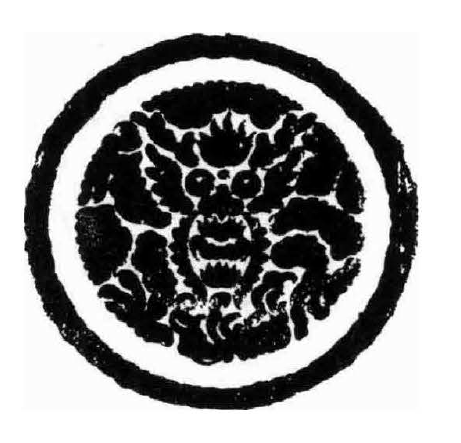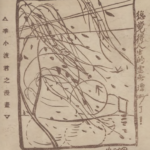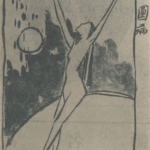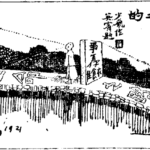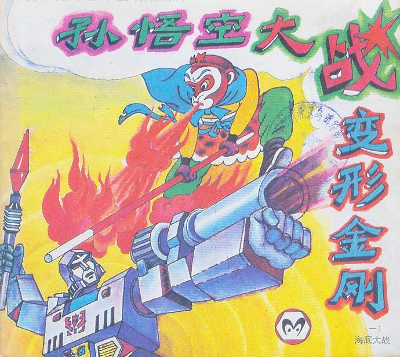Last December, I completed my Masters of Arts in Asian Studies at UBC. Altogether it took me about two and half years. For the first year, that meant attending graduate seminars, doing assigned readings, and writing seminar papers (many of which I’ve since re-purposed as posts on this blog). I also helped organize my department’s graduate conference and worked as a teaching assistant, first in Chinese film and later for Chinese language courses. The last year and a half of my program was dedicated to completing my thesis, a long piece of original research intended to both develop and highlight my mastery of my chosen subject matter. Although I had hoped to complete a comprehensive history of Chinese comics, I soon realized this was far beyond the scope of a MA thesis. With the encouragement of my advisor, Chris Rea, I decided to focus on the Shanghai Manhua Society, an important group of cartoonists who came together in Shanghai in the mid-1920s.
For most scholars, academic research is first and foremost a means to an end. (As a wise man once said, the only good thesis is a finished thesis.) That said, it is also represents a once in a lifetime opportunity to study something which interests you, and (hopefully) share that interest with others. Over the last couple of years, Chinese cartoons and comics have been gradually attracting more and more interest abroad. In Chinese studies, much of this interest is framed within the context of print culture studies, taking inspiration from Jürgen Habermas’ influential concept of the public sphere as the birthplace of modern democracy. I can’t, however, say that I have much of a mind for theory. I like Chinese comics because I like comics and I like China. If that sounds like an easy out, well. Perhaps it is.
Since passing my defense, I’ve been considering putting my entire MA thesis online so that my research will be available to the rest of the world. I’ve also decided to use Creative Commons Attribution-NonCommercial-NoDerivatives 4.0 International License, which means you can share it with anyone you like, as long as you don’t charge money for it. Over the next couple of days I’ll be putting up the whole thing, chapter by chapter. You can also download a PDF version here.
Finally, now that I’m working as a full time translator / agent / consultant / tour guide, any time I spend on this blog is time I could be spending on paid gigs.1 If you’d like to support my research going forward I encourage you to consider sponsoring my blog via Patreon. Thank you!
Zhang Meisun “Emblem for the Manhua Association” 漫畫會會徽 November, 1927.
Table of Contents
List of Tables
List of Figures
Abstract
Acknowledgements
Epigraph
Introduction
Chapter 1 : War, What Is It Good For?
Ye Qianyu: The Student
Ji Xiaobo: The Master
Burnt Bridges and Bad Blood?
Chapter 2 : The Ties That Bind
Ding Song: The Grandfather
Zhang Guangyu: The Godfather
Lu Shaofei: The Portraitist’s Son
Chapter 3 : Wild Cards
Wang Dunqing: The Boy Scout
Huang Wennong: The Missionary’s Son
Hu Xuguang: The Lumberjack
Chapter 4 : Come Together
The Shot Heard Round the Bund
An Unexpected Party
The Northern Expedition
Chapter 5 : The Breaking of the Fellowship
Shanghai Sketch I
Dr. Fix-It and the Pioneer Syndicate
Shanghai Sketch II
Chapter 6 : The Legacy
Birth of the Modern
The Manhua Boom
Censorship and War
Conclusion
Bibliography
Appendix: Tables
Abstract
Towards the end of the 19th century, the first illustrated pictorials began to appear in China. Satirical cartoons found their way into Chinese newspapers and magazines over the following decades, as print technology gradually improved. By the 1910s illustrated pictorials began to proliferate, along with the first examples of humor magazines, a trend which would continue through the 1920s. By the early 1930s, China had over two dozen magazines dedicated to satirical comics, or manhua, as they came to be known. This study looks at the Manhua Society, a group of semi-professional cartoonists whose members were active in Shanghai from roughly 1918 to 1938. By pooling their resources and working under a common banner, the Manhua Society members were not only able to find employment, but also to step into the role of publishers themselves, financed by day jobs in advertising and education. This study reconstructs the history of the society using oral histories, academic studies, and primary source materials (translating many previously unavailable in English). It focuses on eight key members of the Manhua Society: Ye Qianyu, Ji Xiaobo, Ding Song, Zhang Guangyu, Lu Shaofei, Wang Dunqing, Huang Wennong, and Hu Xuguang. These men saw their careers transformed by a series of escalating military conflicts: the May 4 Movement of 1919, the Zhili-Anhui War of 1920, the first Zhili-Fengtian War of 1922, the Jiangsu-Zhejiang War and second Zhili-Fengtian War of 1924, the May 30 Movement of 1925, the Northern Expedition of 1926-1928, including the Shanghai Massacre of 1927, and the first Japanese invasions of Shanghai in 1932 and 1937. Their stories show how the history of Chinese comics was shaped by individuals, as well as organizations. Although this industry was crippled by the Japanese invasion of Shanghai in 1937, the same cartoonists would go on to work in the propaganda offices of World War II, the Chinese Civil War, and the Cold War. In tracing the origins of the Manhua Society, therefore, I argue that it influenced not only the development of cartooning and comics in the Republican era, but also the visual culture of the PRC.
Acknowledgements
First and foremost, I would like to thank the Faculty of Arts at UBC and the Gregory Tso Memorial Scholarship in Asian Studies whose funding made this project possible.
Secondly, I would like thank my advisor, Christopher G. Rea, for his guidance and, most of all, patience as this project made its way towards completion. His knowledge of the visual culture of 19th and 20th century China and willingness to share resources provided this study with an unparalleled foundation of support, as did his assistance with funding and grant applications. He is, in every sense of the word, a mensch.
I would also like to thank Timothy Cheek and John A. Crespi for serving on my committee, and Jerry Schmidt for serving as chair. It is thanks to their close reading and incisive comments and questions that I have been able to shape something resembling an argument out of the crooked timber of my thesis. The remaining knots and splinters are, of course, my own.
More generally, I would like to thank Catherine Swatek for sharing her expertise as both a sinologist and a friend, and Sharalyn Orbaugh for always encouraging me to dig a little bit deeper. Stefania Burk was a pillar of support during all manner of crises. Bruce Rusk provided invaluable advice on digital archives, and Ross King’s suggestion to focus on the founding rather than the failing of the Manhua Society turned out to be just the advice I needed.
Additionally, Carla Nappi was always there with robot coffee when I really needed it, and Robert Hegel provided killer advice for an aspiring grad student, as did Maggie Greene. I also want to Brendan O’Kane for encouraging me to follow in his footsteps by studying abroad in China.
I would like to thank my family and friends in Portland, Shanghai, Harbin, and now Vancouver, for putting up with my obsessions and encouraging my passions.
Finally, I would like to thank my wife Ding, for her constant love and support.
Epigraph
“They were always doing something. Quietly, without interruption, and with great concentration, they carried on with the hundred-and-one small things that made up their world.”
― Tove Jansson, Moominpappa at Sea, 1965, translated by Kingsley Hart
Introduction
Over the last roughly 150 years China has undergone massive changes, going from absolute monarchy to semi-colony, and eventually to a pair of 21st century nation states, the Republic of China and the People’s Republic of China, with equally dramatic changes occurring in Chinese-language print culture. As new technologies introduced from abroad came to replace traditional methods of printing, new types of publications, such as newspapers and magazines, came into vogue. Although a long tradition of illustrated texts exists in China, going back to at least the Tang dynasty (618-907), it was not until the late 19th century that high fidelity illustrated texts could be reproduced quickly and cheaply, spurring an explosion in visual print culture for men and women, rich and poor alike. This democratization of information was unprecedented in Chinese history, and in turn spurred social changes that would transform China.
By the 1920s, Shanghai, then China’s largest metropolis, was experiencing a publishing boom brought about through a confluence of two very different groups of intellectuals: those aligned with the politically-motivated New Culture movement, concerned with issues of language reform and national sovereignty, and those who catered to the tastes of public, through popular literature, music, films, and other forms of entertainment. Both groups sought to capture the attention (and dollars) of a growing audience of increasingly cosmopolitan readers. While New Culture critics disparaged popular writers as the “Mandarin Ducks and Butterflies” clique for their sentimentalism, symbolized by the romantic clichés of yuanyang (Mandarin Ducks, which mate for life) and hudie (butterflies, free flying denizens of the garden, a sexually charged space in traditional Chinese drama and literature), the line between the two groups was not as hard and fast as such appellation might suggest. Given the inherently subjective task of literary analysis, critics more often than not labeled writers based more on whom they associated with than on the actual content of their writing.[1] Writers of all stripes, meanwhile, took a keen interest in the potential of the graphic arts, with the “Butterflies” gravitating towards entertainment, and the New Culture critics to propaganda.
This thesis looks at a very small part of this much larger print boom phenomenon, namely, the emergence and afterlife of the Manhua Society 漫畫會, a group dedicated to the production of manhua (cartoon) periodicals whose members belonged to both sides of the great literary debate. First adopted in the mid-1920s, the Chinese term manhua refers to cartoons in a general sense, and was adopted by a specific group of artist-entrepreneurs to promote their own work. Rather than look at the aesthetic influences (particularly from the West) on their work, as Paul Bevan has done in his recently published monograph, this study is primarily concerned with using oral histories, academic studies, and primary source materials (translating many previously unavailable in English) to reconstruct the life and times of the members of the Manhua Society.[2]
The Manhua Society was formed in late 1926 and disbanded in in 1928, with scholars Bi Keguan and Huang Yuanlin later hailing it as “the first civil cartoon society in Chinese history” 漫畫會是我國歷史最早出現的民間漫畫團體.[3] This is probably an exaggeration, as the Manhua Society was likely only one of several “civil societies” dedicated to the making of cartoons which was formed in the 1920s.[4] It was, however, one of the few to announce its activity with some regularity in the Shenbao and other publications, from its founding in late 1926 though to its apparent breakup in late 1927. Key members of this short-lived organization included Ye Qianyu 葉淺予 (1907-1995), Ji Xiaobo 季小波 (1901-2000), Zhang Guangyu 張光宇 (1900-1965, born Zhang Dengying 張登瀛) and his brother, Zhang Zhengyu 張正宇 (also known as Zhang Zhenyu 張振宇, 1904-1976), Ding Song丁松 (courtesy name Ding Muqin 丁慕琴, 1891-1969? 1972?), Lu Shaofei 魯少飛 (1903-1995), Huang Wennong 黃文農 (1903-1934), and Wang Dunqing 王敦慶 (1899-1990). The Society and its various publications also sought to draw on the talents of a larger pool of cartoonists, and inspired in large part by the political turmoil of the late 1910s and 1920s, these artists turned entrepreneurs saw cartooning not only as an economic opportunity, but also as a moral necessity.[5] In addition to publishing large numbers of political cartoons through various publications during the 1920s and 1930s, members such as Ye Qianyu, Zhang Guangyu, and Wang Dunqing devoted themselves almost exclusively to creating anti-Japanese propaganda after the outbreak of the second Sino-Japanese war in 1937.
When considering the impact of the Manhua Society, however, it is equally important to note that through the diverse work of its members, manhua came to refer to a much larger creative sphere than simply “cartoons.” As Crespi argues,
…the English word “cartoon” can be a misleading translation for the Chinese term manhua. Cognate with the Japanese word “manga,” Chinese magazines like Shanghai Sketch …and Modern Sketch…expanded the meaning of manhua to cover a diversity of graphic forms beyond what we normally think of as “cartoons.”
Indeed, looking at the various cartoon periodicals published during the 1920s and 30s by members of the Manhua Society, it seems that manhua came to be understood as a general category of visual play, exemplified by the cartoon or caricature, but also encompassing photographs, fashion illustrations, advertisements, poster art, and wildly creative typography.
To understand why a group of young men would dedicate themselves to drawing and publishing cartoons (and other works which combined art and humor) in Shanghai in the late 1910s and early 1920s, one must understand the development of the city in which they made their home. Science fiction author J.G. Ballard (who was born in the International Settlement in 1930 and lived in the city until he was 15) once described Shanghai of the early 20th century as
…almost a 21st Century city – huge disparities of wealth and poverty, a multi-lingual media city with dozens of radio stations, dominated by advertising, befouled by disease and pollution, driven by money, populated by twenty different nations, the largest and most dynamic city of the Pacific rim, an important political battleground. In short, a portent of the world we inhabit today.[6]
Here, Ballard would seem to be echoing his cotemporary Marshall McLuhan, who argued that the technology of popular media and communication altered the way we think, not through the merits of the contents it carried, but through the immediacy of its delivery, allowing for a “…retribalizing process wrought by the electric media, which is turning the planet into a global village.”[7] In this way, the illustrated magazines of 1910s and 1920s such as Vanity Fair and Vogue, which Manhua Society members such as Ye Qianyu recall having modelled their own publications on, can be argued to have been a portent of the 21st century media-sphere, marrying current events to trends in fashion and popular culture, foreshadowing television and, ultimately, the internet. Like the internet today, an exciting mix of both high and low culture could be found of the pages of manhua and other illustrated periodicals in Republican-era Shanghai, which struggled to stay afloat in the face of low profits and over-zealous censors.
As media savvy consumers and interpreters of global culture, the Manhua Society and its members left an indelible mark on the visual culture of the Republican-era, which became the cultural heritage of the PRC after Mao Zedong and the communists came to power in 1949. To understand this cultural heritage, we must consider not only the artwork produced, but also the men who produced this artwork and the great sweltering paradox of a city which brought them together.
Continued in Chapter 1…
[1] For examples of the differences in the language used by literary and popular writers, see William A. Lyell’s afterword to his translation of Zhang Henshui’s novel, Shanghai Express: A Thirties Novel, trans. William A. Lyell (Honolulu: Univ of Hawaii Pr, 1997).
[2] Paul Bevan, A Modern Miscellany: Shanghai Cartoon Artists, Shao Xunmei’s Circle and the Travels of Jack Chen, 1926-1938 (Brill, 2015).
[3] Bi Keguan 畢克官 and Huang Yuanlin 黃遠林, Zhongguo Manhua Shi 中國漫畫史 [The History of Chinese Manhua] (文化藝術出版社, 1986), 85.
[4] Other informal groups almost certainly existed in Beijing and Guangzhou, given the existence of cartoon periodicals published in the latter, such as Fifty-cent Funnies 半角漫畫, and the presence of cartoonist and educator Wang Junyi王君異 (1895-1959) in the former. See Ding Xi 丁西, ed., “Banjiao Manhua” 半角漫畫 [Fifty-Cent Funnies], Meishu Cilin 美術辭林, Manhua Yishu Juan 漫畫藝術卷, November 2000, 598 and Ding Xi 丁西, ed., “Wang Junyi” 王君異 [Wang Junyi], Meishu Cilin 美術辭林, Manhua Yishu Juan 漫畫藝術卷, November 2000, 598.
[5] Meeting notes for one gathering state that “…our group has adopted an open format and we welcome new comrades to join. There is no established procedure for soliciting new members, so interested parties are encouraged to contact us” 該會取公開態度、歡迎同志加入、但無徵求會員之手續、願入會者、可與該會接洽云. “Ge tuanti xiaoxi” 各團體消息 [Society News], Shenbao 申報, June 8, 1927, 17.
[6] J.G. Ballard, “Ballard Interviewed by Hans Ulrich Obrist in 2003,” interview by Hans Ulrich Obrist, 2003, http://www.jgballard.ca/media/2003_catalogue_for_beck’s_futures_art_exhibition.html (accessed November 22, 2015).
[7] “The Playboy Interview | Next Nature Network,” n.d., https://www.nextnature.net/2009/12/the-playboy-interview-marshall-mcluhan/ (accessed November 24, 2015).
- I also totally accidentally nuked the whole site while moving it to a new host last week and only barely managed to bring it back through a combination of an old back-up and Google cache. The Lord of Light is merciful. [↩]
